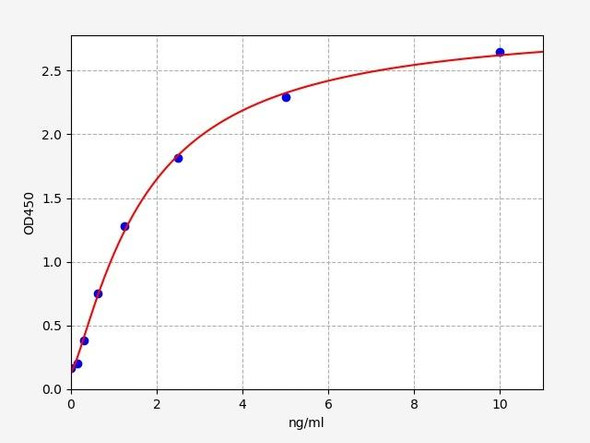Human Catenin beta-1 (CTNNB1) ELISA Kit
- SKU:
- HUEB0079
- Product Type:
- ELISA Kit
- Size:
- 96 Assays
- Uniprot:
- P35222
- Range:
- 0.156-10 ng/mL
- ELISA Type:
- Sandwich
- Synonyms:
- CTNNBeta1, CTNNB1, CTNNB, MRD19, armadillo, beta 1, 88kD, beta-catenin, catenin, cadherin-associated protein, beta 1, 88kDa, catenin beta-1
- Reactivity:
- Human
Description
| Product Name: | Human Catenin beta-1 (CTNNB1) ELISA Kit |
| Product Code: | HUEB0079 |
| Alias: | Catenin beta-1, Beta-catenin, CTNNB1, CTNNB, OK/SW-cl.35, PRO2286 |
| Uniprot: | P35222 |
| Reactivity: | Human |
| Range: | 0.156-10 ng/mL |
| Detection Method: | Sandwich |
| Size: | 96 Assay |
| Storage: | Please see kit components below for exact storage details |
| Note: | For research use only |
| UniProt Protein Function: | CTNNB1: a regulator of cell adhesion and a key downstream effector in the Wnt signaling pathway. Implicated early embryonic development and tumorigenesis. Phosphorylated and destabilized by CK1 and GSK-3beta. Stabilized cytoplasmic beta-catenin is a hallmark of a variety of cancers. Stabilized beta-catenin translocates to the nucleus, where it acts as a transcriptional activator of T-cell factor (TCF)-regulated genes. Interacts with the PDZ domain of TAX1BP3, inhibiting its transcriptional activity. Two alternatively spliced human isoforms have been described. |
| UniProt Protein Details: | Protein type:Transcription factor; Motility/polarity/chemotaxis; Cell adhesion; Oncoprotein; Nuclear receptor co-regulator; Actin-binding Chromosomal Location of Human Ortholog: 3p21 Cellular Component: centrosome; basolateral plasma membrane; intercellular junction; fascia adherens; cytosol; beta-catenin destruction complex; transcription factor complex; cell-cell adherens junction; membrane; lamellipodium; perinuclear region of cytoplasm; cytoplasm; synapse; dendritic shaft; lateral plasma membrane; spindle pole; focal adhesion; tight junction; catenin complex; cell cortex; Z disc; nucleoplasm; adherens junction; microvillus membrane; apical part of cell; plasma membrane; nucleus; cell junction Molecular Function:protein C-terminus binding; transcription coactivator activity; transcription factor binding; protein phosphatase binding; ionotropic glutamate receptor binding; protein binding; signal transducer activity; enzyme binding; androgen receptor binding; cadherin binding; double-stranded DNA binding; protein complex binding; estrogen receptor binding; nitric-oxide synthase binding; SMAD binding; transcription factor activity; kinase binding; alpha-catenin binding; nuclear hormone receptor binding Biological Process: regulation of myelination; regulation of centriole-centriole cohesion; positive regulation of apoptosis; protein heterooligomerization; positive regulation of transcription, DNA-dependent; regulation of fibroblast proliferation; cell maturation; negative regulation of chondrocyte differentiation; T cell differentiation in the thymus; positive regulation of fibroblast growth factor receptor signaling pathway; osteoclast differentiation; Wnt receptor signaling pathway through beta-catenin; cell-cell adhesion; positive regulation of endothelial cell differentiation; regulation of cell fate specification; embryonic foregut morphogenesis; positive regulation of mesenchymal cell proliferation; male genitalia development; ectoderm development; synapse organization and biogenesis; cell adhesion; bone resorption; response to drug; positive regulation of neuroblast proliferation; positive regulation of I-kappaB kinase/NF-kappaB cascade; regulation of smooth muscle cell proliferation; transcription, DNA-dependent; hair cell differentiation; negative regulation of protein sumoylation; patterning of blood vessels; genitalia morphogenesis; muscle cell differentiation; midgut development; smooth muscle cell differentiation; positive regulation of transcription from RNA polymerase II promoter; embryonic digit morphogenesis; negative regulation of transcription, DNA-dependent; oocyte development; embryonic forelimb morphogenesis; negative regulation of osteoclast differentiation; glial cell fate determination; endodermal cell fate commitment; apoptosis; cell-matrix adhesion; neuron migration; dorsal/ventral axis specification; cell fate specification; positive regulation of histone H3-K4 methylation; negative regulation of transcription from RNA polymerase II promoter; embryonic hindlimb morphogenesis; response to estradiol stimulus; negative regulation of cell proliferation; central nervous system vasculogenesis; positive regulation of MAPKKK cascade; pancreas development; positive regulation of interferon type I production; fallopian tube development; proximal/distal pattern formation; layer formation in the cerebral cortex; negative regulation of mitotic cell cycle, embryonic; cell structure disassembly during apoptosis; Wnt receptor signaling pathway; hair follicle morphogenesis; thymus development; in utero embryonic development; regulation of T cell proliferation; neural plate development; stem cell maintenance; embryonic axis specification; synaptic vesicle transport; gastrulation with mouth forming second; liver development; regulation of angiogenesis; odontogenesis of dentine-containing teeth; myoblast differentiation; negative regulation of oligodendrocyte differentiation; Schwann cell proliferation; positive regulation of osteoblast differentiation; response to cadmium ion; ureteric bud branching; response to cytokine stimulus; androgen receptor signaling pathway; epithelial to mesenchymal transition; positive regulation of muscle cell differentiation; embryonic heart tube development; innate immune response; lens morphogenesis in camera-type eye; anterior/posterior axis specification Disease: Pilomatrixoma; Mental Retardation, Autosomal Dominant 19; Ovarian Cancer; Colorectal Cancer; Hepatocellular Carcinoma |
| NCBI Summary: | The protein encoded by this gene is part of a complex of proteins that constitute adherens junctions (AJs). AJs are necessary for the creation and maintenance of epithelial cell layers by regulating cell growth and adhesion between cells. The encoded protein also anchors the actin cytoskeleton and may be responsible for transmitting the contact inhibition signal that causes cells to stop dividing once the epithelial sheet is complete. Finally, this protein binds to the product of the APC gene, which is mutated in adenomatous polyposis of the colon. Mutations in this gene are a cause of colorectal cancer (CRC), pilomatrixoma (PTR), medulloblastoma (MDB), and ovarian cancer. Three transcript variants encoding the same protein have been found for this gene.[provided by RefSeq, Oct 2009] |
| UniProt Code: | P35222 |
| NCBI GenInfo Identifier: | 461854 |
| NCBI Gene ID: | 1499 |
| NCBI Accession: | P35222.1 |
| UniProt Secondary Accession: | P35222,Q8NEW9, Q8NI94, Q9H391, A8K1L7, |
| UniProt Related Accession: | P35222 |
| Molecular Weight: | |
| NCBI Full Name: | Catenin beta-1 |
| NCBI Synonym Full Names: | catenin (cadherin-associated protein), beta 1, 88kDa |
| NCBI Official Symbol: | CTNNB1Â Â |
| NCBI Official Synonym Symbols: | CTNNB; MRD19; armadillo  |
| NCBI Protein Information: | catenin beta-1 |
| UniProt Protein Name: | Catenin beta-1 |
| UniProt Synonym Protein Names: | Beta-catenin |
| Protein Family: | Catenin |
| UniProt Gene Name: | CTNNB1Â Â |
| UniProt Entry Name: | CTNB1_HUMAN |
| Component | Quantity (96 Assays) | Storage |
| ELISA Microplate (Dismountable) | 8×12 strips | -20°C |
| Lyophilized Standard | 2 | -20°C |
| Sample Diluent | 20ml | -20°C |
| Assay Diluent A | 10mL | -20°C |
| Assay Diluent B | 10mL | -20°C |
| Detection Reagent A | 120µL | -20°C |
| Detection Reagent B | 120µL | -20°C |
| Wash Buffer | 30mL | 4°C |
| Substrate | 10mL | 4°C |
| Stop Solution | 10mL | 4°C |
| Plate Sealer | 5 | - |
Other materials and equipment required:
- Microplate reader with 450 nm wavelength filter
- Multichannel Pipette, Pipette, microcentrifuge tubes and disposable pipette tips
- Incubator
- Deionized or distilled water
- Absorbent paper
- Buffer resevoir
*Note: The below protocol is a sample protocol. Protocols are specific to each batch/lot. For the correct instructions please follow the protocol included in your kit.
Allow all reagents to reach room temperature (Please do not dissolve the reagents at 37°C directly). All the reagents should be mixed thoroughly by gently swirling before pipetting. Avoid foaming. Keep appropriate numbers of strips for 1 experiment and remove extra strips from microtiter plate. Removed strips should be resealed and stored at -20°C until the kits expiry date. Prepare all reagents, working standards and samples as directed in the previous sections. Please predict the concentration before assaying. If values for these are not within the range of the standard curve, users must determine the optimal sample dilutions for their experiments. We recommend running all samples in duplicate.
| Step | |
| 1. | Add Sample: Add 100µL of Standard, Blank, or Sample per well. The blank well is added with Sample diluent. Solutions are added to the bottom of micro ELISA plate well, avoid inside wall touching and foaming as possible. Mix it gently. Cover the plate with sealer we provided. Incubate for 120 minutes at 37°C. |
| 2. | Remove the liquid from each well, don't wash. Add 100µL of Detection Reagent A working solution to each well. Cover with the Plate sealer. Gently tap the plate to ensure thorough mixing. Incubate for 1 hour at 37°C. Note: if Detection Reagent A appears cloudy warm to room temperature until solution is uniform. |
| 3. | Aspirate each well and wash, repeating the process three times. Wash by filling each well with Wash Buffer (approximately 400µL) (a squirt bottle, multi-channel pipette,manifold dispenser or automated washer are needed). Complete removal of liquid at each step is essential. After the last wash, completely remove remaining Wash Buffer by aspirating or decanting. Invert the plate and pat it against thick clean absorbent paper. |
| 4. | Add 100µL of Detection Reagent B working solution to each well. Cover with the Plate sealer. Incubate for 60 minutes at 37°C. |
| 5. | Repeat the wash process for five times as conducted in step 3. |
| 6. | Add 90µL of Substrate Solution to each well. Cover with a new Plate sealer and incubate for 10-20 minutes at 37°C. Protect the plate from light. The reaction time can be shortened or extended according to the actual color change, but this should not exceed more than 30 minutes. When apparent gradient appears in standard wells, user should terminatethe reaction. |
| 7. | Add 50µL of Stop Solution to each well. If color change does not appear uniform, gently tap the plate to ensure thorough mixing. |
| 8. | Determine the optical density (OD value) of each well at once, using a micro-plate reader set to 450 nm. User should open the micro-plate reader in advance, preheat the instrument, and set the testing parameters. |
| 9. | After experiment, store all reagents according to the specified storage temperature respectively until their expiry. |
When carrying out an ELISA assay it is important to prepare your samples in order to achieve the best possible results. Below we have a list of procedures for the preparation of samples for different sample types.
| Sample Type | Protocol |
| Serum | If using serum separator tubes, allow samples to clot for 30 minutes at room temperature. Centrifuge for 10 minutes at 1,000x g. Collect the serum fraction and assay promptly or aliquot and store the samples at -80°C. Avoid multiple freeze-thaw cycles. If serum separator tubes are not being used, allow samples to clot overnight at 2-8°C. Centrifuge for 10 minutes at 1,000x g. Remove serum and assay promptly or aliquot and store the samples at -80°C. Avoid multiple freeze-thaw cycles. |
| Plasma | Collect plasma using EDTA or heparin as an anticoagulant. Centrifuge samples at 4°C for 15 mins at 1000 × g within 30 mins of collection. Collect the plasma fraction and assay promptly or aliquot and store the samples at -80°C. Avoid multiple freeze-thaw cycles. Note: Over haemolysed samples are not suitable for use with this kit. |
| Urine & Cerebrospinal Fluid | Collect the urine (mid-stream) in a sterile container, centrifuge for 20 mins at 2000-3000 rpm. Remove supernatant and assay immediately. If any precipitation is detected, repeat the centrifugation step. A similar protocol can be used for cerebrospinal fluid. |
| Cell culture supernatant | Collect the cell culture media by pipette, followed by centrifugation at 4°C for 20 mins at 1500 rpm. Collect the clear supernatant and assay immediately. |
| Cell lysates | Solubilize cells in lysis buffer and allow to sit on ice for 30 minutes. Centrifuge tubes at 14,000 x g for 5 minutes to remove insoluble material. Aliquot the supernatant into a new tube and discard the remaining whole cell extract. Quantify total protein concentration using a total protein assay. Assay immediately or aliquot and store at ≤ -20 °C. |
| Tissue homogenates | The preparation of tissue homogenates will vary depending upon tissue type. Rinse tissue with 1X PBS to remove excess blood & homogenize in 20ml of 1X PBS (including protease inhibitors) and store overnight at ≤ -20°C. Two freeze-thaw cycles are required to break the cell membranes. To further disrupt the cell membranes you can sonicate the samples. Centrifuge homogenates for 5 mins at 5000xg. Remove the supernatant and assay immediately or aliquot and store at -20°C or -80°C. |
| Tissue lysates | Rinse tissue with PBS, cut into 1-2 mm pieces, and homogenize with a tissue homogenizer in PBS. Add an equal volume of RIPA buffer containing protease inhibitors and lyse tissues at room temperature for 30 minutes with gentle agitation. Centrifuge to remove debris. Quantify total protein concentration using a total protein assay. Assay immediately or aliquot and store at ≤ -20 °C. |
| Breast Milk | Collect milk samples and centrifuge at 10,000 x g for 60 min at 4°C. Aliquot the supernatant and assay. For long term use, store samples at -80°C. Minimize freeze/thaw cycles. |









